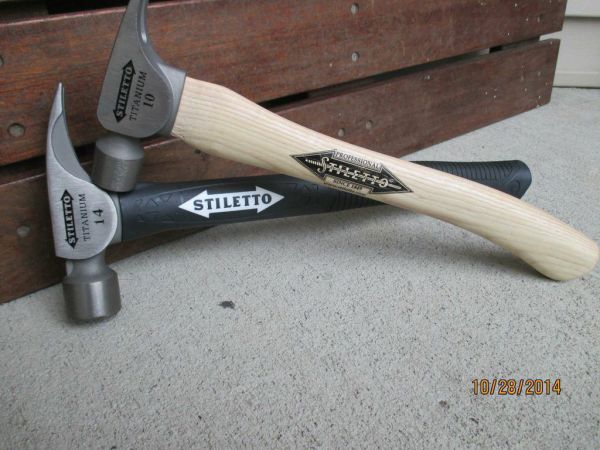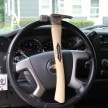Titanium Hammers vs. Steel Hammers
Titanium Hammers vs. Steel Hammers Which One Is Better?
The titanium hammer vs. steel hammer debate has been going on at my job site for a few years now. The questions all address whether titanium hammers are worth the cost, which is sometimes 4-5 times more than a steel hammer, and do they REALLY prevent injuries.
Titanium transfers energy efficiently
The major attraction to using a titanium hammer is vibration and weight. Titanium, as a metal has the same strength as steel with 45% less weight, and exhibits much less vibration than steel. Some hammer manufacturers claim up to 10 times less vibration.
Strength Example:
• 400lbs static load steel / 30% more vibration
• 800lbs static load titanium
The fact that titanium hammers weigh-in at half that as their steel counterparts, while still delivering the same amount of power to the head of the nail is impressive. This reduction in weight makes for a great argument that the user will experience less fatigue over the course of a day, week, and year.
Reduction in recoil-shock vibration is another great feature of titanium. It goes to reason that titanium can help to save your elbow from the shock of hammering. This was the argument that got my attention. Less damage to the body is a good retirement plan!
The lighter titanium hammer also allows users to obtain 97% of their hammer swing energy going into the nail, compared to 70% with a regular steel hammer. This results in a more efficient nail-driving.
Steel Still Lives On the Job-site
Steel hammers are still preferred by many carpenters because they cost way less and exhibit more “knockdown power.” The truth of this argument is a moot point, we all know that heavier hammers are always more effective at pounding framing members or beam into place, or when moving a wall into position.
When it comes to demo work, I don’t buy the heavier hammer argument. The goal is to protect one’s body and when doing demo work contractors should not swing hammers in direction that your elbow is NOT designed to move.
There’s a huge difference between nailing vs. wailing a hammer. [Open elbow, baseball swing] Operators should try to avoid wailing and keep the arm and elbow moving in a more naturally motion, as this will prevent injuries.
In Defense of Steel Hammers:
On average, titanium dampens vibrations up to ten times better than high carbon steels, but this doesn’t take into account that some steel hammers have optimized their design to offset this.
Today, higher end steel hammers are designed around better performing high carbon steels and handles that further improve dampening performance. How much better a titanium compared to steel hammers dampens vibrations depends on several factors:
• Hammer head metallurgy
• Handle material
• Hammer design
 Photo: My favorite finish hammer a Stiletto 10 ounce with Hickory handle
Photo: My favorite finish hammer a Stiletto 10 ounce with Hickory handle
What about the Handles?
Hickory handles, are stronger than synthetic material, and also have the benefit of less vibration. Wood transfers less vibration that metal.
Some hammers have a fiberglass shaft core [hard material] or a glass filled nylon and a Thermoplastic rubber [TPR] over molded handle, all of these have been designed to reduce vibration. Proponents of synthetic handles argue that wood loses its vibration dampening over time.
On my carpentry crew we all use Stiletto titanium hammers. Some of use prefer wood handles and others TPR synthetic.
I’ve talked to many carpenters who have gone to steel shanks because over time their wood handle hammers loosen at the head. This is because vibration traveling thru the handle degrades the bond between the handle and head.
Wood handles are kiln dried and then turned at an optimal moisture content of 10-12%, over course of 10 years the wood dries out and the handle loosens.
Wood Handle Tips:
If your old school and you appreciate a wood handle, like me, then here’s a few tips to keep your hammer working well:
• Look for a hammer that uses radial wedges to hold the hammer head onto the Hickory handle. Flat barbed wedges were the old standard but they tend to loosen over time.
• Some manufacturers use flat wedges to hold the handle to the head. Flat wedges only compress side to side and we’ve seen many manufactures adding two wedges, set at an angle to offset this issue.
• Radial wedges are a better way to attach a hammer head to a handle. The radial wedges force the material bi-laterally, in every direction resulting in less loosening forward and aft. The end result is a longer hammer service life
Hammer TIP: Tightening a loose hammer head
Old time carpenters used to soak their hammer head eye in water to swell the wood and tighten it to the handle.
The better way to do this is to use mineral oil. Mineral oil is soaked into the wood capillaries in the handle and maintains moisture in the wood. To do this, simply set your hammer upside down in mineral oil and the wood fiber will swell, tightening the head bond. Your hammer will last longer.
Overall Titanium Wins:
The true test to appreciate hammer vibration differences between titanium and steel hammers is to strike them simultaneously on a concrete floor. You only have to do this once to see the benefits of titanium. This test is what sold my guys to start carrying and using Stiletto hammers.
Titanium hammers offer excellent vibration dampening, and the lighter weight metal translates to easier swings with less fatigue and impact on the nerves and tendons in the arm.
Using a titanium hammer makes sense, especially when I think of my own injuries and guys that I know that are in a “survival mode.” These are the guys that take Vicoden or Ibroprofren to keep pain and swelling down just to get through the day. Many of these guys are on a union job site and in clear violation of drug policies, but they do what they need to work, that’s sad.
My take away from the titanium vs. steel argument is that titanium’s primary ergonomic benefit is less recoil with less fatigue being a secondary benefit. I predict that over time you will see a reduction in arm injuries caused by frequent heavy hammer use.
The Titanium Hammer vs. Steel Hammer Debate Video





















